Cite this document
(Classical Symphonies by Franz Joseph Haydn Essay Example | Topics and Well Written Essays - 1250 words - 1, n.d.)
Classical Symphonies by Franz Joseph Haydn Essay Example | Topics and Well Written Essays - 1250 words - 1. https://studentshare.org/music/1824074-non-topic
Classical Symphonies by Franz Joseph Haydn Essay Example | Topics and Well Written Essays - 1250 words - 1. https://studentshare.org/music/1824074-non-topic
(Classical Symphonies by Franz Joseph Haydn Essay Example | Topics and Well Written Essays - 1250 Words - 1)
Classical Symphonies by Franz Joseph Haydn Essay Example | Topics and Well Written Essays - 1250 Words - 1. https://studentshare.org/music/1824074-non-topic.
Classical Symphonies by Franz Joseph Haydn Essay Example | Topics and Well Written Essays - 1250 Words - 1. https://studentshare.org/music/1824074-non-topic.
“Classical Symphonies by Franz Joseph Haydn Essay Example | Topics and Well Written Essays - 1250 Words - 1”. https://studentshare.org/music/1824074-non-topic.


